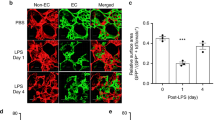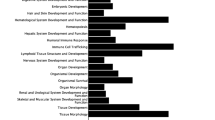Abstract
Activation of the zinc-finger transcription factor early growth response (Egr)-1, initially linked to developmental processes, is shown here to function as a master switch activated by ischemia to trigger expression of pivotal regulators of inflammation, coagulation and vascular hyperpermeability. Chemokine, adhesion receptor, procoagulant and permeability-related genes are coordinately upregulated by rapid ischemia-mediated activation of Egr-1. Deletion of the gene encoding Egr-1 strikingly diminished expression of these mediators of vascular injury in a murine model of lung ischemia/reperfusion, and enhanced animal survival and organ function. Rapid activation of Egr-1 in response to oxygen deprivation primes the vasculature for dysfunction manifest during reperfusion. These studies define a central and unifying role for Egr-1 activation in the pathogenesis of ischemic tissue damage.
This is a preview of subscription content, access via your institution
Access options
Subscribe to this journal
Receive 12 print issues and online access
$209.00 per year
only $17.42 per issue
Buy this article
- Purchase on Springer Link
- Instant access to full article PDF
Prices may be subject to local taxes which are calculated during checkout






Similar content being viewed by others
References
Semenza, G. Perspectives on oxygen sensing. Cell 98, 281–284 (1999).
Zhu, H. & Bunn, H. Oxygen sensing and signaling: impact on the regulation of physiologically important genes. Respir. Physiol. 115, 239–247 (1999).
Ratcliffe, P., O'Rourke, J., Maxwell, P. & Pugh, C. Oxygen sensing, HIF-1 and the regulation of mammalian gene expression. J. Exp. Biol. 201, 1153–1162 (1998).
Yan, S.-F. et al. Tissue factor transcription driven by Egr-1 is a critical mechanism of murine pulmonary fibrin deposition in hypoxia. Proc. Natl. Acad. Sci. USA 95, 8298–8303 (1998).
Milbrandt, J. A nerve growth factor induced gene encodes a possible transcriptional regulatory factor. Science 238, 797–799 (1988).
Gashler, A. & Sukhatme, V. Egr-1: prototype of a zinc finger family of transcription factors. Prog. Nucl. Acids Res. and Molec. Biol. 50, 191–224 (1995).
Nguyen, H., Hoffman-Lieberman, B. & Liebermann, D. Egr-1 is essential for and restricts differentiation along the macrophage cell lineage. Cell 72, 197–209 (1993).
Yan, S-F. et al. Hypoxia-associated induction of Early Growth Response-1 gene expression. J. Biol. Chem. 274, 15030–15040 (1999).
Okada, K. et al. Potentiation of endogenous fibrinolysis and rescue from lung ischemia-reperfusion injury in IL-10-reconstituted IL-10 null mice. J. Biol. Chem. 275, 21468–21476, 2000.
Brand, T. et al. Proto-oncogene expression in porcine myocardium subjected to ischemia and reperfusion. Circ. Res. 71, 1351–1360 (1992).
Ouellette, A., Malt, R., Sukhatme, V. & Bonventre, J. Expression of two “immediate early” genes, Egr-1 and c-fos, in response to renal ischemia and during compensatory renal hypertrophy in mice. J. Clin. Invest. 85, 766–771 (1990).
Safirstein, R., Price, P., Saggi, S. & Harris, R. Changes in gene expression after temporary renal ischemia. Kidney Intl. 37, 1515–1521 (1990).
Lee, S. et al. Luteinizing hormone deficiency and female infertility in mice lacking the transcription factor NGFI-A (Egr-1). Science 273, 1219–1221 (1996).
Lefer, A. Role of the β2-integrins and immunoglobulin superfamily members in myocardial ischemia-reperfusion. Ann. Thorac. Surg. 68, 1920–1930 (1999).
Wang, C., et al. Cardiac graft ICAM-1 and IL-1 expression mediate primary isograft failure and induction of ICAM-1 in organs remote from the site of transplantation. Circ. Res. 82, 762–772 (1998).
Lemay, S., Rabb, H., Postler, G. & Singh, A. Prominent and sustained upregulation of gp130-signaling cytokines and the chemokine MIP-2 in murine renal ischemia-reperfusion injury. Transplant 69, 959–963 (2000).
Liu, P. et al. Role of endogenous nitric oxide in TNF-α and IL-1–β generation in hepatic ischemia-reperfusion. Shock 13, 217–223 (2000).
Touzani, O., Boutin, H., Chuquet, J. & Rothwell, N. Potential mechanisms of IL-1 involvement in cerebral ischemia. J. Neuroimmunol. 100, 203–215 (1999).
Mitsui, Y. The expression of proinflammatory cytokine mRNA in the sciatic-tibial nerve of ischemia-reperfusion injury. Brain Res. 844, 192–195 (1999).
Rollins, B. Chemokines. Blood 90, 909–928 (1997).
Kunkel, S. Through the looking glass: the diverse in vivo activities of chemokines. J. Clin. Invest. 104, 1333–1334 (1999).
Colletti, L., Green, M., Burdick, M., Strieter, R. The ratio of ELR+ to ELR- CXC chemokines affects the lung and liver injury following hepatic ischemia/reperfusion in the rat. Hepatology 31, 435–445 (2000).
Yoshidome, H., Kato, A., Edwards, M. & Lentsch, A. IL-10 inhibits pulmonary NF-kB activation and lung injury by hepatic ischemia-reperfusion. Am. J. Physiol. 277, L919–L923 (1999).
Lentsch, A. et al. Chemokine involvement in hepatic ischemia/reperfusion injury in mice: roles for MIP-2 and KC. Hepatology 27, 1172–1177 (1998).
Bless, N. et al. Roles for C-X-C chemokines and C5a in lung injury after hindlimb ischemia-reperfusion. Am. J. Physiol. 276, L57–L63 (1999).
Gourmala, N. et al. Differential and time-dependent expression of JE/MCP-1 mRNA by astrocytes and macrophages in rat brain: effects of ischemia and peripheral LPS administration. J. Neuroimmunol. 74, 35–44 (1997).
Wang, X. et al. Prolonged expression of IP-10 in ischemic cortex after permanent occlusion of the middle cerebral artery in rat. J. Neurochem. 71, 1194–1204 (1998).
Collen, D. & Lijnen, H. Fibrin-specific fibrinolysis. Ann. N. Y. Acad. Sci. 667, 259–271 (1992).
Loskutoff, D., Sawdey, M., Keeton, M. & Schneiderman, J. Regulation of PAI-1 gene expression in vivo. Thromb. & Haemost. 70, 135–137 (1993).
Leung, D. et al. VEGF is a secreted angiogenic mitogen. Science 246, 1306–1309 (1989).
Dvorak, H., Brown, L., Detmar, M. & Dvorak, A. VPF/VEGF, microvascular hyperpermeability, and angiogenesis. Am. J. Pathol. 146, 1029–1039 (1995).
Hayashi, T., Abe, K., Suzuki, H. & Itoyama, Y. Rapid induction of VEGF gene expression after transient middle cerebral artery occlusion in rats. Stroke 28, 2039–2044 (1997).
Lee, S. et al. Early expression of angiogenesis factors in acute myocardial ischemia. N. Engl. J. Med. 342, 626–633 (2000).
VanBruggen, N. et al. VEGF antagonism reduces edema formation and tissue damage in ischemia/reperfusion injury in the mouse brain. J. Clin. Invest. 104, 1613–1620 (1999).
Weiss, S. Tissue destruction by neutrophils. N. Engl. J. Med. 320, 365–376 (1989).
Pober, J. & Cotran, R. Cytokines and endothelial cell biology. Physiol. Revs. 70, 427–451 (1990).
Schechter, A. et al. Tissue factor is induced by MCP-1 in human aortic smooth muscle and THP-1 cells. J. Biol. Chem. 272, 28568–28573 (1997).
Clauss, M. et al. VEGF: a tumor-derived polypeptide that induces endothelial cell and monocyte procoagulant activity, and promotes monocyte migration. J. Exp. Med. 172, 1535–1545 (1990).
Maltzman, J., Carmen, J. & Monroe, J. Transcriptional regulation of the ICAM-1 gene in antigen receptor- and phorbol ester-stimulated B lymphocytes: role for transcription factor Egr-1. J. Exp. Med. 183, 1747–1759 (1996).
Forsythe, J. et al. Activation of VEGF gene transcription by HIF-1. Molec. Cell. Biol. 16, 4604–4613 (1996).
Khachigian, L., Lindner, V., Williams, A. & Collins, T. Egr-1-induced endothelial gene expression: a common theme in vascular injury. Science 271, 1427–1431 (1996).
Svaren, J. et al. NAB2, a corepressor of NGFI-A (EGR-1), and Krox20, is induced by proliferative, and differentiative stimuli. Mol. Cell. Biol. 16, 3545–3553 (1996).
Morishita, R. et al. In vivo transfection of cis element “decoy” against NF-kB binding site prevents myocardial infarction. Nature Med. 3, 894–899 (1997).
Schneider, A. et al. NF-kB is activated and promotes cell death in focal cerebral ischemia. Nature Med. 5, 554–550 (1999).
Millet, I. et al. Inhibition of NF-kB activity and enhancement of apoptosis by neuropeptide CGRP. J. Biol. Chem. 275, 15114–15121 (2000).
Cahir-McFarland, E. NF-kB inhibition causes spontaneous apoptosis in EB virus-transformed lymphoblastoid cells. Proc. Natl. Acad. Sci. USA 97, 6055–6060 (2000).
Saadane, N., Alpert, L. & Chalifour, L. Altered molecular response to adrenoreceptor-induced cardiac hypertrophy in Egr-1-deficient mice. Am. J. Physiol. 278, H796–805 (2000).
Cenci, S., Weitzmann, M., Gentile, M., Aisa, M. & Pacifici, R. M-CSF neutralization and Egr-1 deficiency prevent ovariectomy-induced bone loss. J. Clin. Invest. 105, 1279–1287 (2000).
Goldblum, S., Wu, K. & Jay, M. Lung myeloperoxidase as a measure of pulmonary leukostasis in rabbits. J. App. Physiol. 59, 1978–1985 (1985).
Ikomminoth, P. Detection of mRNA in tissue sections using DIG-labeled RNA and oligonucleotide probes. in, Nonradioactive In Situ Hybridization Application Manual, 2nd edition (Boehringer-Mannheim, Germany 126–135 (1996).
Acknowledgements
This work was supported by grants from the USPHS (HL63967, HL55397 and HL59488), the LeDucq Foundation and the Surgical Research Foundation.
Author information
Authors and Affiliations
Corresponding author
Rights and permissions
About this article
Cite this article
Yan, SF., Fujita, T., Lu, J. et al. Egr-1, a master switch coordinating upregulation of divergent gene families underlying ischemic stress. Nat Med 6, 1355–1361 (2000). https://doi.org/10.1038/82168
Received:
Accepted:
Issue Date:
DOI: https://doi.org/10.1038/82168
This article is cited by
-
The CD2v protein of African swine fever virus inhibits macrophage migration and inflammatory cytokines expression by downregulating EGR1 expression through dampening ERK1/2 activity
Veterinary Research (2023)
-
An atlas of transcribed human cardiac promoters and enhancers reveals an important role of regulatory elements in heart failure
Nature Cardiovascular Research (2023)
-
Characterisation of changes in global genes expression in the lung of ICR mice in response to the inflammation and fibrosis induced by polystyrene nanoplastics inhalation
Toxicological Research (2023)
-
JNK-dependent phosphorylation and nuclear translocation of EGR-1 promotes cardiomyocyte apoptosis
Apoptosis (2022)
-
Pathophysiology of deep vein thrombosis
Clinical and Experimental Medicine (2022)



